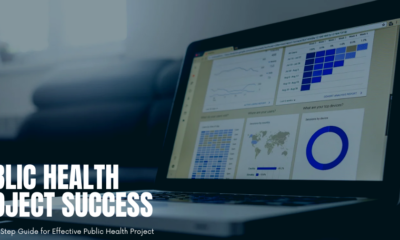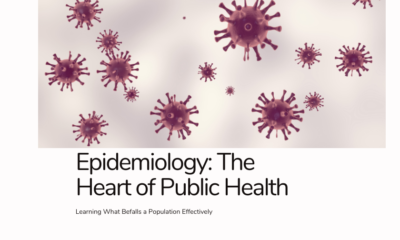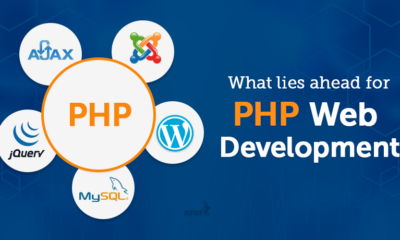Health & Fitness
Most Popular Research Methods and Their Application in Evidence-Based Public Health

Evidence-based public health (EBPH) is a paradigm that emphasizes the use of scientific research and evidence in formulating and implementing public health policies, programs, and interventions. This approach ensures that public health actions are effective, efficient, equitable, and ethical. In the contemporary public health landscape, reliance on empirical evidence has become crucial in addressing the complexities of health issues such as pandemics, chronic diseases, health disparities, and environmental health challenges.
The foundation of EBPH lies in robust research methodologies. Research methods in public health are the tools and techniques used to collect, analyze, and interpret data to generate evidence. These methods range from quantitative to qualitative, and their application depends on the research question, the nature of the health issue, and the context within which the research is conducted. Understanding the most popular research methods and their application in EBPH is essential for public health practitioners, policymakers, and researchers who seek to improve health outcomes through informed decision-making.
Quantitative Research Methods
Quantitative research involves systematic empirical investigation of observable phenomena via statistical, mathematical, or computational techniques. These methods are characterized by collecting numerical data, which can be quantified and subjected to statistical analysis to test hypotheses, identify patterns, and make predictions. In public health, quantitative research is crucial for assessing disease prevalence, evaluating interventions’ effectiveness, and establishing causal relationships between risk factors and health outcomes.
1) Randomized Controlled Trials (RCTs)
Randomized Controlled Trials (RCTs) are considered the gold standard in public health research. In an RCT, participants are randomly assigned to the intervention or control groups. The intervention group receives the treatment or intervention being studied, while the control group receives a placebo or standard care. The outcomes of both groups are then compared to determine the effectiveness of the intervention.
Application in EBPH:
RCTs are extensively used in EBPH to evaluate the efficacy of new treatments, vaccines, and public health interventions. For instance, RCTs were pivotal in assessing the effectiveness of COVID-19 vaccines. By randomly assigning participants to vaccine or placebo groups, researchers could objectively measure the vaccine’s ability to prevent infection, hospitalization, and death.
Advantages:
- High internal validity due to randomization.
- Ability to establish causality.
- Minimizes bias and confounding factors.
Limitations:
- Often expensive and time-consuming.
- May not always be ethical or feasible, especially in cases where withholding treatment poses a risk.
- Limited generalizability if the study population does not reflect the broader community.
2) Cohort Studies
Cohort studies are observational studies where a group of individuals (cohort) is followed over time to assess the development of outcomes based on their exposure to certain risk factors. Cohort studies can be prospective (following participants into the future) or retrospective (using existing data to look back at exposures and outcomes).
Application in EBPH:
Cohort studies are instrumental in understanding the long-term effects of risk factors on health outcomes. For example, the Framingham Heart Study, a landmark cohort study, has provided invaluable insights into the risk factors for cardiovascular disease, influencing public health policies on smoking, diet, and physical activity.
Advantages:
- Can study multiple outcomes for a single exposure.
- Ideal for studying rare exposures.
- Less prone to recall bias compared to case-control studies.
Limitations:
- time-consuming and expensive, especially for prospective cohort studies.
- Susceptible to lose to follow-up, which can introduce bias.
- Cannot establish causality as definitively as RCTs.
3) Case-Control Studies
Case-control studies are observational studies that compare individuals with a particular condition or disease (cases) to those without the condition (controls). The study looks backward to determine whether the cases were more likely to have been exposed to a specific risk factor than the controls.
Application in EBPH:
Case-control studies are commonly used in public health research to identify disease risk factors. For instance, they were crucial in identifying smoking as a major risk factor for lung cancer. These studies help generate hypotheses that can be tested in more rigorous research designs, like cohort studies or RCTs.
Advantages:
- Cost-effective and quicker to conduct than cohort studies.
- Efficient for studying rare diseases.
- Can study multiple risk factors simultaneously.
Limitations:
- Prone to recall and selection biases.
- Cannot directly measure the incidence of disease.
- Less reliable in establishing temporal relationships between exposure and outcome.
4) Cross-sectional Studies
Cross-sectional studies involve collecting data at a single point in time from a population or a representative subset. These studies measure the prevalence of outcomes or exposures in a population but do not follow individuals over time.
Application in EBPH:
Cross-sectional studies are widely used in public health to assess the prevalence of diseases, health behaviors, and risk factors in a population. For example, cross-sectional surveys are often used to estimate the prevalence of smoking, obesity, or mental health disorders in different demographic groups.
Advantages:
- Quick and relatively inexpensive.
- Useful for generating hypotheses.
- Can assess the burden of disease in a population.
Limitations:
- Cannot establish causality or temporal relationships.
- Prone to selection bias if the sample is not representative.
- May miss associations that vary over time.
5) Ecological Studies
Ecological studies analyze data at the population or group level rather than the individual level. These studies often use aggregate data, such as national statistics on smoking rates and lung cancer incidence, to identify potential associations between exposures and outcomes.
Application in EBPH:
Ecological studies are instrumental in public health for exploring trends and patterns in health outcomes across different populations or geographical regions. For instance, ecological studies have examined the relationship between air pollution levels and respiratory health outcomes across cities.
Advantages:
- Can analyze data from large populations.
- Useful for generating hypotheses and identifying broad patterns.
- Relatively inexpensive and quick to conduct.
Limitations:
- Ecological fallacy: associations observed at the group level may not hold true at the individual level.
- Cannot establish causality or control for confounding variables at the individual level.
- Limited by the availability and accuracy of aggregate data.
Qualitative Research Methods
Qualitative research methods involve the collection and analysis of non-numerical data to understand phenomena, experiences, and behaviors in depth. These methods are particularly valuable in exploring complex social, cultural, and psychological factors that influence public health. Qualitative research provides rich, detailed insights that complement quantitative findings, offering a more holistic understanding of health issues.
1) In-Depth Interviews
In-depth interviews are a qualitative research method that involves conducting one-on-one interviews with participants to explore their experiences, beliefs, and perceptions in detail. The interviewer uses open-ended questions to encourage participants to share their thoughts freely, allowing for the collection of nuanced and in-depth data.
Application in EBPH:
In-depth interviews are commonly used in public health research to explore individual experiences with health behaviors, healthcare services, and disease management. For example, interviews with patients can provide valuable insights into their experiences with chronic disease management, revealing barriers to adherence to treatment plans and potential areas for intervention.
Advantages:
- Provides rich, detailed data.
- Allows exploration of sensitive topics that may not be easily discussed in group settings.
- Flexible and adaptable to the participant’s responses.
Limitations:
- Time-consuming and resource-intensive.
- Data analysis can be complex and subjective.
- May be influenced by interviewer bias.
2) Focus Groups
Focus groups involve guided discussions with a small group of participants to explore their views, experiences, and attitudes on a specific topic. The interaction between participants in a focus group can stimulate new ideas and perspectives that may not emerge in individual interviews.
Application in EBPH:
Focus groups are widely used in public health to gather community input on health interventions, programs, and policies. For instance, focus groups with different demographic groups can help public health professionals understand cultural attitudes toward vaccination and identify potential barriers to vaccine uptake.
Advantages:
- Allows for the exploration of diverse perspectives and group dynamics.
- Can generate new ideas and hypotheses through participant interaction.
- Efficient for collecting data from multiple participants simultaneously.
Limitations:
- Group dynamics can influence individual responses, leading to conformity or dominance by certain participants.
- May not be suitable for discussing sensitive or personal topics.
- Requires skilled moderation to ensure productive and inclusive discussions.
3) Case Studies
Case studies involve an in-depth examination of a single case or a small number of cases within their real-life context. The case can be an individual, a group, an organization, or an event. Case studies use multiple data sources, including interviews, observations, and documents, to build a comprehensive understanding of the case.
Application in EBPH:
Case studies are valuable in public health for exploring complex health issues, interventions, and policies in specific contexts. For example, a case study of a community-based health program can provide insights into the factors that contributed to its success or failure, offering lessons for similar programs in other settings.
Advantages:
- Provides a deep understanding of the case in its context.
- Allows for the exploration of complex phenomena that cannot be captured by quantitative methods alone.
- Flexible and can be adapted to different research questions and contexts.
Limitations:
- Limited generalizability due to the focus on a single case or a small number of cases.
- Time-consuming and resource-intensive.
- Risk of researcher bias in data collection and interpretation.
4) Ethnography
Ethnography is a qualitative research method that involves the immersive study of a community or culture. Researchers use participant observation, interviews, and other methods to gather data on the daily lives, behaviors, and social interactions of the group being studied. The goal of ethnography is to understand the group’s worldview from an insider’s perspective.
Application in EBPH:
Ethnography is particularly useful in public health for understanding the cultural and social determinants of health behaviors. For example, ethnographic studies in rural communities can reveal how cultural beliefs and practices influence health behaviors, such as maternal and child health practices, enabling the design of culturally appropriate interventions.
Advantages:
- Provides deep, contextualized insights into health behaviors and practices.
- Can uncover hidden or tacit knowledge that may not be accessible through other methods.
- Flexible and adaptable to the research context.
Limitations:
- Requires significant time and immersion in the community, which can be resource-intensive.
- Data collection and analysis can be subjective and influenced by the researcher’s perspective.
- May face ethical challenges related to privacy and informed consent.
5) Grounded Theory
Grounded theory is a qualitative research method that aims to develop a theory grounded in the data collected during the research process. Researchers collect and analyze data iteratively, allowing themes and concepts to emerge from the data, which are then used to build a theoretical framework.
Application in EBPH:
Grounded theory is useful in public health for developing theories about complex health behaviors and social processes. For example, grounded theory can be used to explore how people make decisions about health behaviors, such as smoking cessation or dietary changes, leading to the development of new theoretical models that inform public health interventions.
Advantages:
- Allows for the development of theory directly from the data.
- Flexible and adaptable to the research context.
- Can uncover new concepts and relationships that may not be anticipated.
Limitations:
- Data collection and analysis are time-consuming and require a high level of expertise.
- The iterative process can be challenging to manage, especially in large studies.
- The resulting theory may be context-specific and not easily generalizable.
Mixed Methods Research
Mixed methods research combines quantitative and qualitative research methods to provide a more comprehensive understanding of public health issues. This approach allows researchers to capitalize on the strengths of both methodologies while mitigating their limitations.
1) Convergent Parallel Design
In a convergent parallel design, quantitative and qualitative data are collected simultaneously but analyzed separately. The findings from both types of data are then compared and integrated to provide a more comprehensive understanding of the research question.
Application in EBPH:
This design is often used in public health to explore complex health issues where both numerical data (e.g., prevalence rates) and contextual data (e.g., patient experiences) are important. For instance, a study on the effectiveness of a health intervention might collect quantitative data on health outcomes and qualitative data on patient satisfaction simultaneously.
Advantages:
Provides a comprehensive understanding of the research problem.
- Allows for the triangulation of data, increasing the validity of the findings.
- Can identify areas where quantitative and qualitative data converge or diverge.
Limitations:
- Requires expertise in both quantitative and qualitative methods.
- Can be time-consuming and resource-intensive.
- The integration of data can be complex and challenging.
2) Explanatory Sequential Design
In an explanatory sequential design, quantitative data is collected and analyzed first, followed by the collection and analysis of qualitative data to explain or expand upon the quantitative findings.
Application in EBPH:
This design is commonly used in public health research to explore the reasons behind quantitative findings. For example, if a quantitative study finds a significant disparity in health outcomes between different demographic groups, qualitative research can be conducted to explore the underlying social, cultural, or economic factors contributing to this disparity.
Advantages:
- Allows for a deeper understanding of quantitative findings.
- Flexible and adaptable to different research contexts.
- Can help identify new variables or hypotheses for further quantitative research.
Limitations:
- Time-consuming, as it involves two distinct phases of data collection and analysis.
- Requires expertise in both quantitative and qualitative methods.
- The qualitative phase may be influenced by the findings of the quantitative phase, leading to potential bias.
3) Exploratory Sequential Design
In an exploratory sequential design, qualitative data is collected and analyzed first, followed by the collection and analysis of quantitative data to test or build upon the qualitative findings.
Application in EBPH:
This design is useful in public health research when little is known about a phenomenon, and qualitative data is needed to develop hypotheses or identify variables for quantitative testing. For example, exploratory qualitative research might reveal new risk factors for a disease, which can then be tested quantitatively in a larger population.
Advantages:
- Allows for the development of new hypotheses and variables for quantitative testing.
- Provides a rich, contextual understanding before quantitative testing.
- Flexible and adaptable to different research contexts.
Limitations:
- Time-consuming, as it involves two distinct phases of data collection and analysis.
- Requires expertise in both qualitative and quantitative methods.
- The quantitative phase may be constrained by the findings of the qualitative phase.
Application of Research Methods in Evidence-Based Public Health
The application of research methods in EBPH is multifaceted, involving the integration of evidence from different sources to inform public health practice. The choice of research method depends on the research question, the nature of the health issue, the available resources, and the context in which the research is conducted.
1) Formulating Public Health Policies
Research methods play a crucial role in the formulation of public health policies. For instance, quantitative methods such as RCTs and cohort studies provide evidence on the effectiveness and safety of interventions, while qualitative methods such as focus groups and interviews offer insights into the acceptability and feasibility of these interventions within communities. Mixed methods research can combine these approaches to develop policies that are both evidence-based and contextually appropriate.
2) Designing and Evaluating Public Health Interventions
Designing effective public health interventions requires a deep understanding of the health issue, the target population, and the context. Quantitative methods such as RCTs and cross-sectional studies can identify the most effective interventions, while qualitative methods such as ethnography and case studies can ensure that these interventions are culturally sensitive and feasible. Evaluation of these interventions also relies on a combination of quantitative and qualitative methods to assess both their impact and their implementation.
3) Monitoring and Surveillance of Public Health Issues
Monitoring and surveillance are critical components of EBPH. Quantitative methods such as cross-sectional studies and ecological studies are commonly used for surveillance, providing data on the prevalence and distribution of health issues. These methods are essential for detecting emerging health threats, tracking trends over time, and identifying at-risk populations. Qualitative methods can complement these efforts by exploring the underlying reasons for observed trends and identifying potential barriers to surveillance efforts.
4) Addressing Health Disparities
Addressing health disparities requires an understanding of the complex social, economic, and cultural factors that contribute to inequities in health outcomes. Qualitative methods such as in-depth interviews and ethnography are particularly valuable in this context, as they provide insights into the lived experiences of marginalized populations and the barriers they face in accessing healthcare. Quantitative methods can then be used to measure the extent of these disparities and evaluate the effectiveness of interventions aimed at reducing them.
5) Responding to Public Health Emergencies
In public health emergencies, such as pandemics or natural disasters, rapid and effective responses are essential. Research methods play a critical role in guiding these responses. Quantitative methods, such as RCTs, are used to test the efficacy of emergency interventions (e.g., vaccines, treatments), while cohort studies and cross-sectional surveys can assess the impact of the emergency on population health. Qualitative methods are also important for understanding the social and psychological impacts of the emergency and ensuring that response efforts are culturally appropriate and responsive to the needs of affected communities.
Conclusion
Research methods are the cornerstone of evidence-based public health. The use of quantitative, qualitative, and mixed methods research enables public health professionals to generate robust evidence, understand complex health issues, and develop effective interventions and policies. By integrating these methods into the practice of public health, we can ensure that public health actions are grounded in evidence, leading to better health outcomes for all populations. As public health challenges continue to evolve, the ongoing development and application of research methods will be crucial in advancing the field and improving global health.
-

 Press Release4 days ago
Press Release4 days agoClinical Trials Market Set for Robust Growth, Driven by Drug Development Surge and Digital Innovation
-

 Press Release5 days ago
Press Release5 days agoFill-Finish Pharmaceutical Contract Manufacturing Market Expected to Flourish Amid Biopharmaceutical Boom and Global Outsourcing Trend by 2035
-

 Press Release7 days ago
Press Release7 days agoBellarium ($BEL) Price Prediction: Could It Hit $5 by 2026?
-

 Business6 days ago
Business6 days agoHow Managed IT Solutions Help Small Teams Compete at Enterprise Scale
-

 Press Release5 days ago
Press Release5 days agoGreen Bio Chemicals Market Poised for Sustainable Growth amidst Global Shift to Eco-Friendly Alternatives by 2035
-
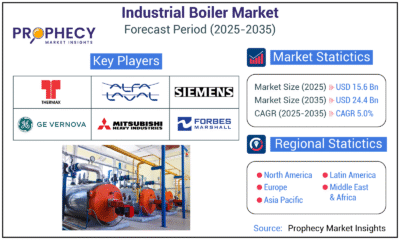
 Press Release5 days ago
Press Release5 days agoIndustrial Boiler Market Expected to Surpass USD 24.4 Billion by 2035 Amid Growing Demand for Energy Efficiency and Industrialization
-
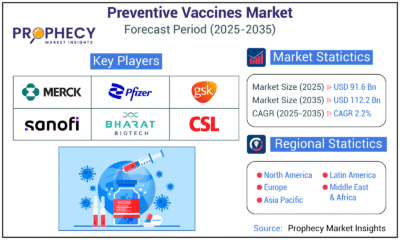
 Press Release5 days ago
Press Release5 days agoPreventive Vaccines Market to Witness Strong Growth by 2035
-

 Press Release5 days ago
Press Release5 days agoPet Food Nutraceutical Market Set for Robust Expansion Amid Rising Demand for Pet Wellness by 2035




